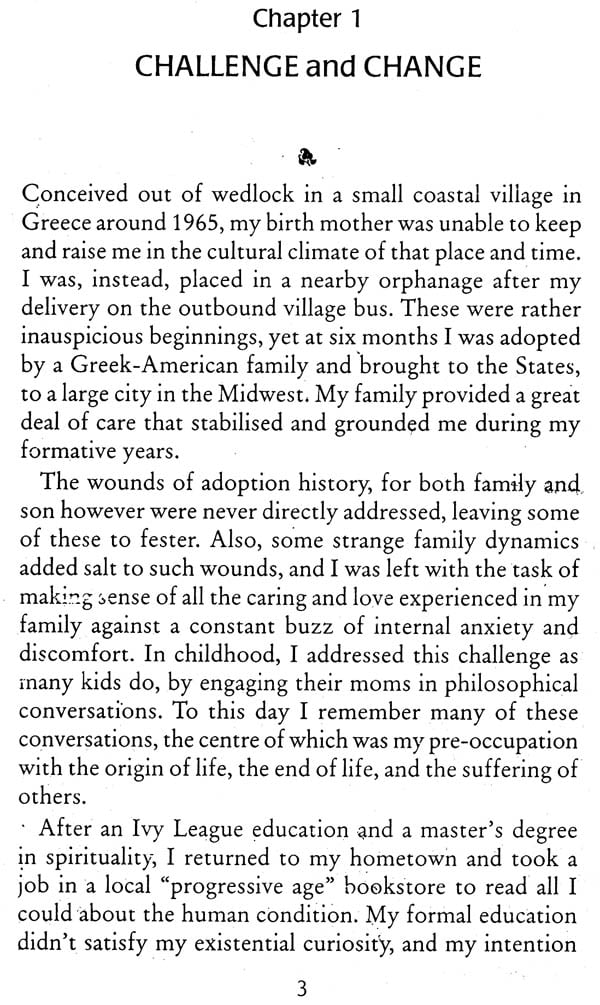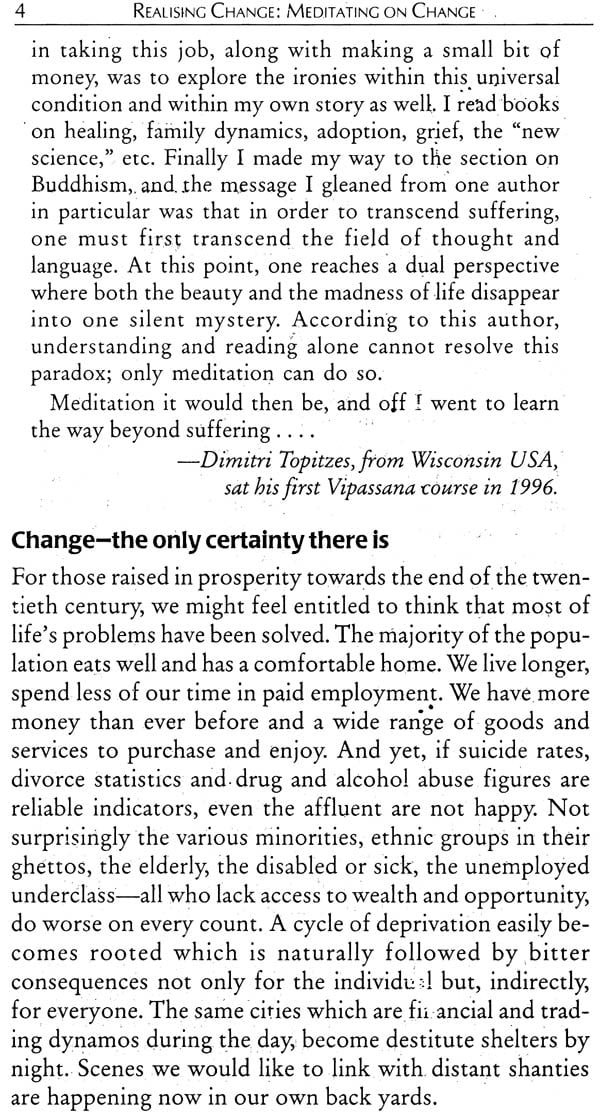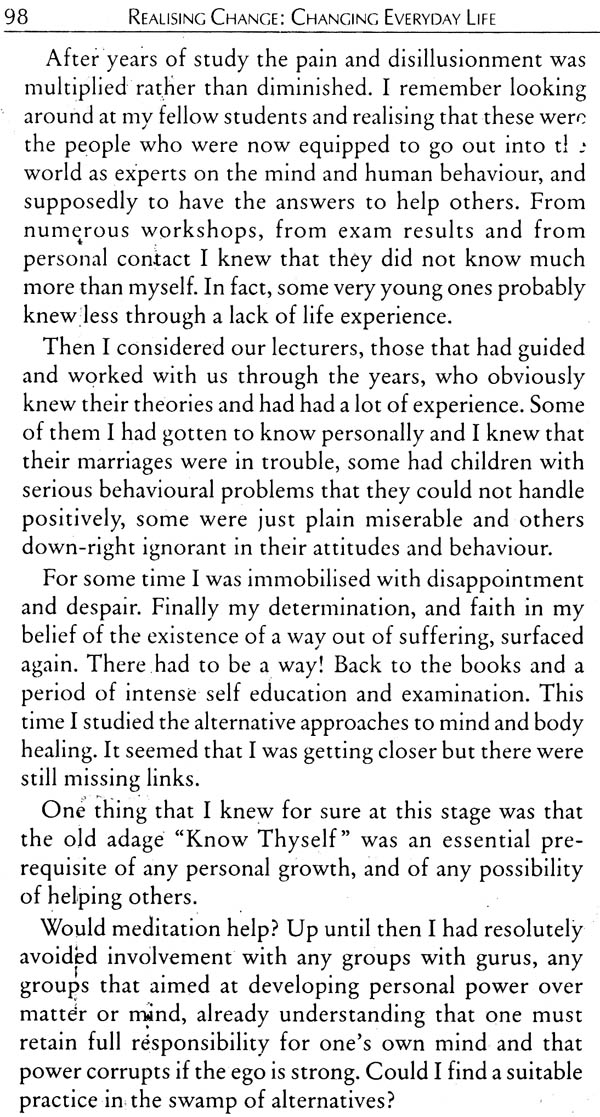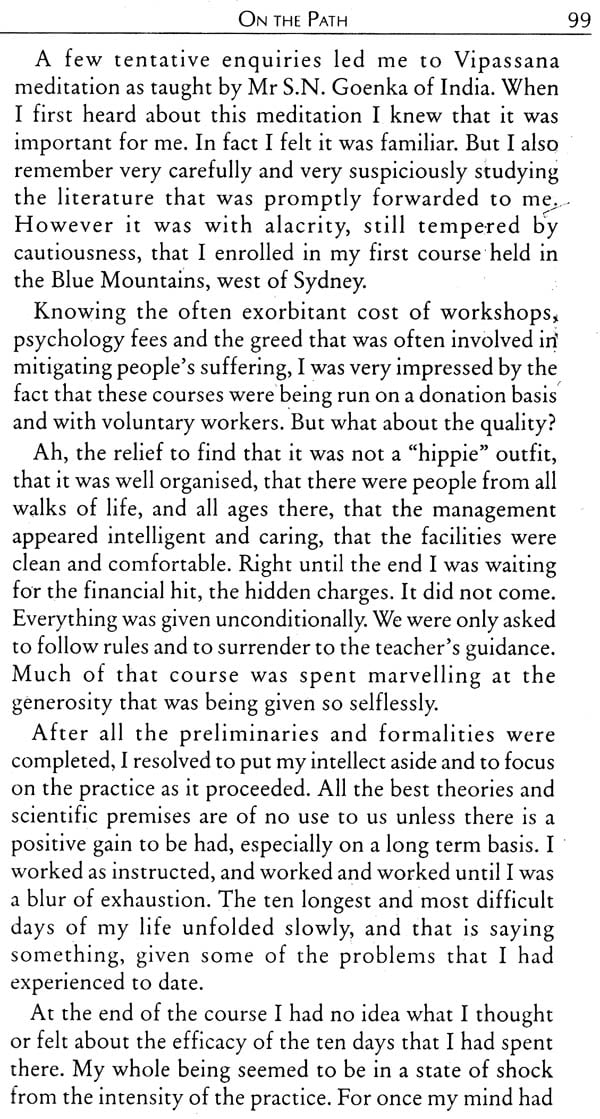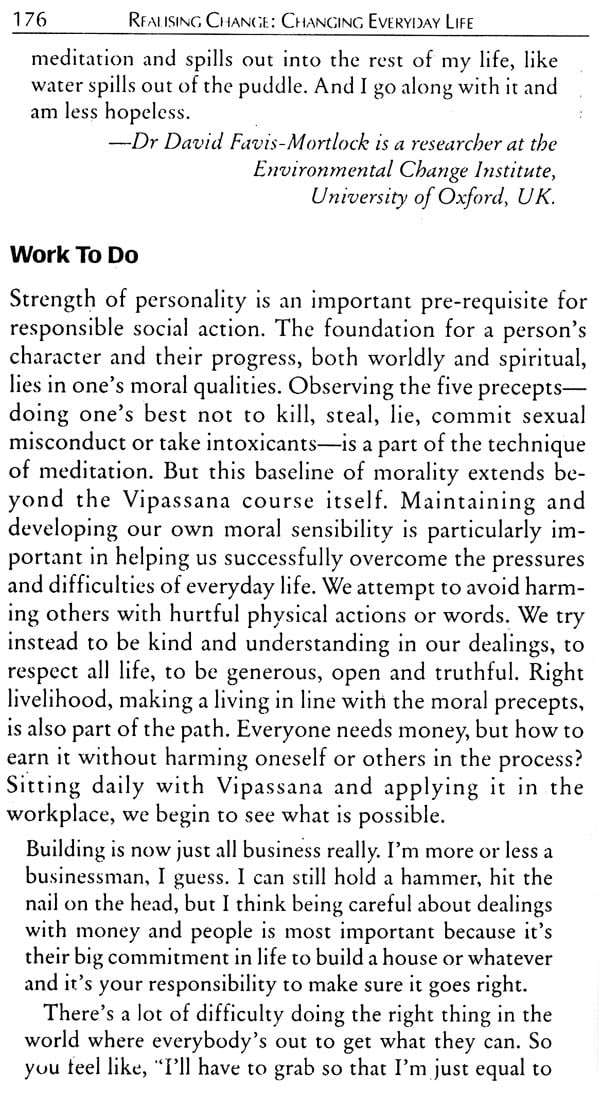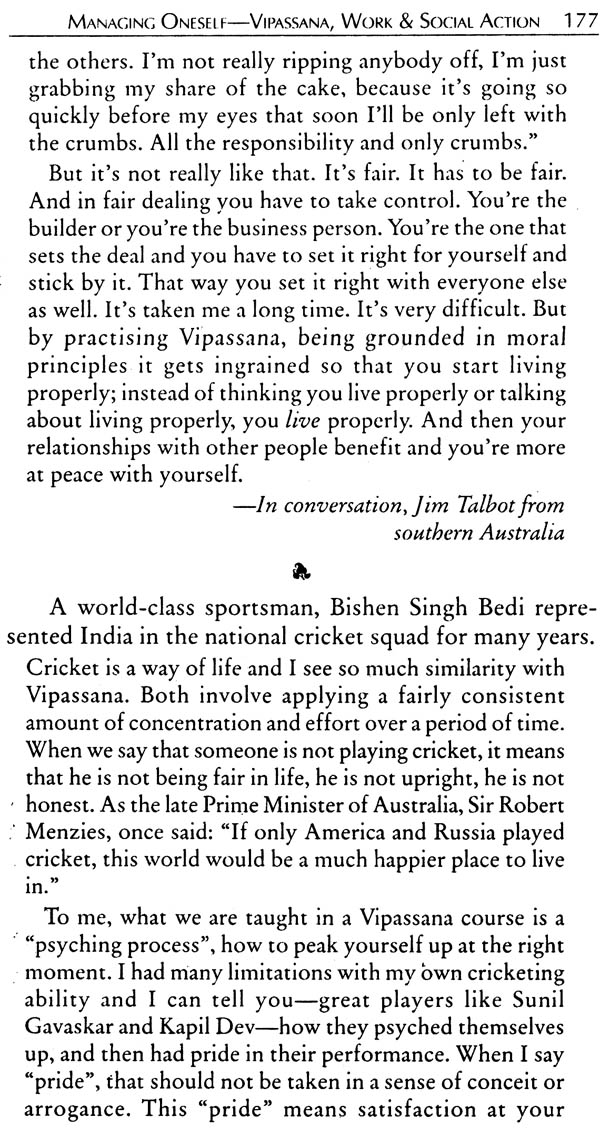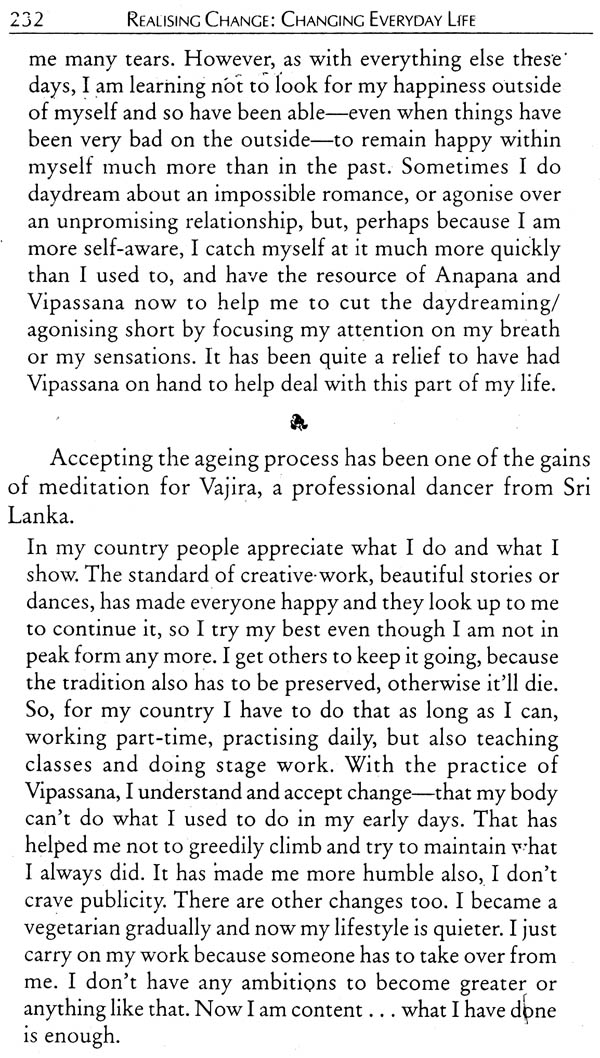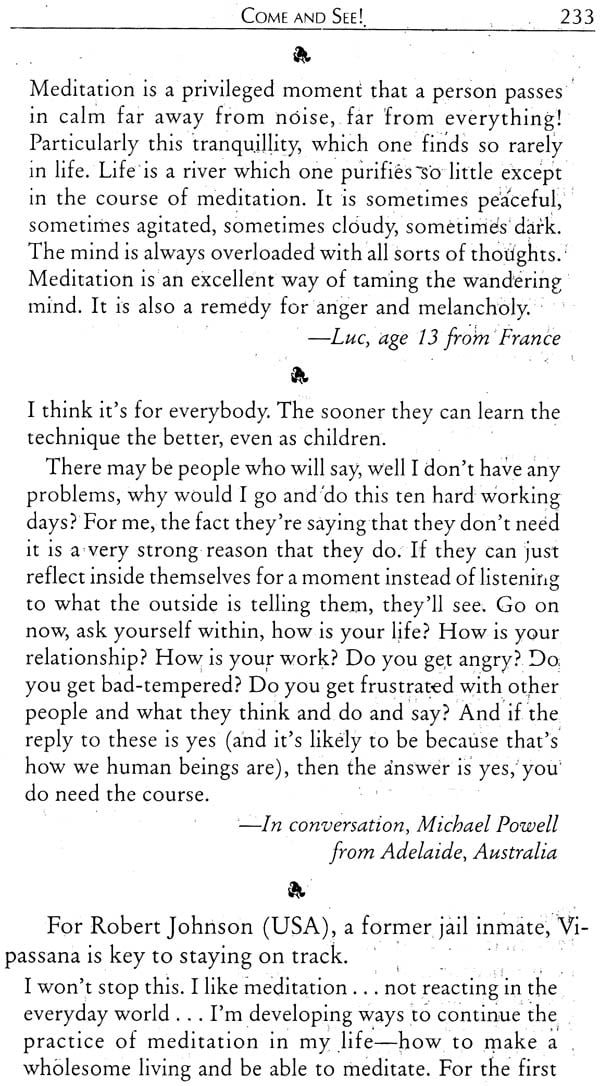
Realising Change (Vipassana Meditation in Action)
Book Specification
| Item Code: | NAW165 |
| Publisher: | Vipassana Research Institute |
| Language: | English |
| Edition: | 2009 |
| ISBN: | 8174142347 |
| Pages: | 260 |
| Cover: | PAPERBACK |
| Other Details | 8.50 X 5.50 inch |
| Weight | 330 gm |
Book Description
Sri Satyanarayanji Goenka was born in Mandalay, Myanmar in 1924. Although he topped the list of all successful candidates in the whole of Myanmar in the tenth class he could not continue his studies further because of financial constraints of his family. At a very early age he set up many commercial and industrial institutions and earned fabulous wealth. He also established many social and cultural centres. Because of tension he became a victim of migraine, which could not be cured by doctors of Myanmar and of other countries in the world. Then some one suggested him to take a course of Vipassana. Vipassana has done well not only to him but it has also been benefiting many others.
He learned Vipassana from Sayagyi U Ba Khin in 1955. Sitting at the feet of his teacher he practices it for fourteen years He also studied the words of the Buddha during this period. He came to India in 1969 and conducted the first vipassana course in Mumbai. After that a series of courses were held. In 1976 the first residential course of vipassana was held in Igatpuri and the first centre of vipassana was established here. Up till now 167 centres have been established all over the world. New centres also are coming up. At these centres 1200 trained teachers teach vipassana in 59 languages of the world. Not only ten- day courses are conducted at these centres but also at some centres 20-day, 30-day, 45-day and 60-day courses are conducted. All courses are free of charge. The expenses on food and accommodation etc. are met by the self-willed Dana given by those who benefited from the course. Seeing its benevolent nature vipassana courses are held not only for the inmates of jails and school children in the world but also for police personnels, judges, government officers etc.
Despite the greater availability of meditation courses in re- cent times, the term Vipassana meditation and Its potential remain largely unknown in the West. This book, featuring accounts by practitioners leading everyday lives, aims to make Vipassana both better known and more clearly. under- stood.
Two decades back, I had the good fortune to learn the technique of Vipassana directly from S.N. Goenka, a modern lay meditation master In a tradition dating back to the time of the Buddha, Since then, like countless others, I have come to appreciate what a priceless gift Vipassana is. I know through my own experience, personally and professionally, that the benefits I have received from this meditation practice today are indeed enormous. I am profoundly indebted to Mr. Goenka, whose teaching suffuses this book, and who is a tireless and exemplary ambassador for Vipassana around the globe.
Realising Change has been five years in the making. Many people worldwide have generously given their time, energy and skill to helping the Project come to fruition. I am particularly grateful to the dozens of meditators—students and teachers—who submitted stories about their own experience of Vipassana. It has only been possible to include a sample here. In making this compilation, I have also been fortunate to have a wealth of existing source material in different media to draw upon: the Vipassana Research Institute (India) and Partyatti (USA) and their authors for an extensive list of books, articles and seminar papers; Karuna Films, Film-makers David Donnentield, Michael Norton and Gerald Frape and transcribers for scripts and camera interviews; Michael Green and Kirk Brown for photographic images; Paul Fleischman for permission to extract from Cultivating Inner Peace.
My job has been more anthologist, than originator— to weave personal narratives into a straightforward account of Vipassana meditation and its relevance to contemporary, life. Special thanks to editors Rick Crutcher ot Pariyatti and to Bill Hart for their perceptive comments, suggestions and patient guidance. By repeatedly driving us back to the basics their advice undoubtedly improved the text. Thanks too due to the U.K. Vipassana Trust for invaluable access to staff and facilities at the Hereford meditation centre.
Friends Kirk and Reinette Brown and my wife Shelina also read everything and were unfailingly encouraging—the ideal support team.
Vipassana has been a central part of my lite for the past twenty-four years and the text naturally reflects my own experience and understanding, both as a meditator and in my role as an assistant teacher. Where there are short- comings, they are mine alone and no reflection on the teaching, which is flawless.
Deepest thanks to all who have contributed to this joyful work. May its merits be shared with every one of them.
Where to now?
Hurricane-force changes characterise the times. Forever raising or dashing our fortunes, they test us to the limit. Is there shelter in the storm? The world won’t stop to let us off, so what to do and which route to go? Do we bend or break? Vipassana is a practice of experiencing change—face to face with full understanding—moment by moment throughout our days. By realising change—face to face with full understanding—we can be doers rather than done-tos. The aim of this book is to introduce Vipassana meditation as a tried and tested way of solving our everyday problems.
The book 1s written both as celebration and invitation; a celebration of a living tradition of meditation which is being practised around the world today, positively transforming people’s lives in great ways and small, as it has unfailingly for over two thousand years; an invitation to journey together into a fascinating realm of feeling, thought and action.
Vipassana is an ancient meditation technique of India. The Buddha discovered it, attained full enlightenment using it and made it the essence of his teaching, which spread throughout the Indian sub-continent and then on to neighbouring countries. For five hundred years Vipassana flourished in India but then eventually it became polluted and was lost there.
However in Burma (now Myanmar) a chain of devoted teachers maintained the theory and the practice of the technique in its original form over the centuries. Sayagyi U Ba Khin, a respected lay meditation teacher and high government official, was the person directly responsible for relaunching Vipassana in the modern era. At his centre in Rangoon he taught foreigners as well as native Burmese. Amongst his closest students was S.N. Goenka, a Burmese businessman of Indian origin whose family had settled in Myanmar some generations before. In 1969, after fourteen years studying meditation and assisting his teacher, Mr Goenka returned to India. The mission entrusted to him by U Ba Khin was to take Vipassana back to its birthplace, the land of the Buddha, and from there to spread it around the world. Accordingly Mr Goenka started to give courses 1n Vipassana, first in India and then abroad. In time, meditation centres exclusively devoted to the teaching were established.
Although Vipassana has its origin in India and has been preserved in the Buddhist tradition, it contains nothing of a sectarian nature and can be accepted and applied by people of any background. In the West people often feel uneasy at the mention of meditation. Various negative associations are made: with "cults"; with "other religions"; with "mysticism". In sum, people often feel about meditation, "This is not for us". By its progress over the past thirty years Vipassana has shown how unfounded these anxieties are. The approach is practical, rational and scientific—an objective investigation _ of our own minds and bodies, free from any ritual or blind belief. Members of all religions and none, coming from every part of the world and every walk of life, are successfully — practising Vipassana. This should come as no surprise. Our problems are universal and the solution must likewise be universal. Now, as in the past, East and West are ultimately One. Tangible evidence of the technique’s effectiveness 1s offered here in anecdote and research. Through the practice of Vipassana and across all cultural boundaries, we will see how individuals are not only developing their own potential as human beings but are able to make a. greater contribution to society as a whole.
The invitation, dear reader, is this. You’ll find an out- line description of the technique in these pages so that you know what’s involved. However the book is not a do-it- yourself meditation manual and shouldn’t be used as such. There’s no substitute for learning Vipassana by your own personal experience. For this you need to undertake a ten- day course with an authorised teacher in a supportive environment. These courses are designed so that you can. discover first-hand how to meditate and get the best results.
Alongside the account of the technique is a sampling of the voices of meditators from different communities: young and old, female and male, simple and sophisticated. Some contributors’ names have been altered by request. Each has his or her own story—how they came to Vipassana, what they’ve learned, the struggles, the gains; all humanity at the water’s edge, finding common refreshment in a practice focused on peace, happiness, compassion and loving kindness.
This is the terrain we’ll be travelling.
The book is arranged in three parts:
Section A: "Vipassana—Meditating on Change" looks at the impact of change on our lives today, what Vipassana meditation is and what happens on a ten-day course.
Section B: "Vipassana—Changing Everyday Life" de- scribes the various ways that individuals and organisations are applying the teaching in everyday situations, at home, with friends and in settings such as education, business and administration, social re- form and health.
Appendices provide information for those wanting to find out more about Vipassana and how to set about joining a course.
May what you read here give encouragement and direction to your own search for happiness and truth.
**Contents and Sample Pages**

